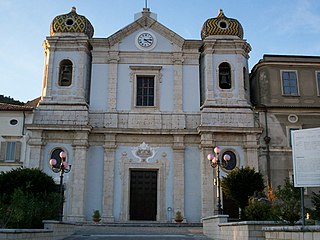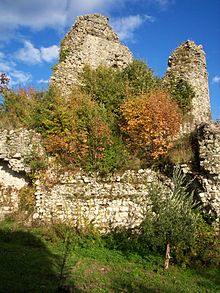
Benevento is a city and comune of Campania, Italy, capital of the province of Benevento, 50 kilometres (31 mi) northeast of Naples. It is situated on a hill 130 metres above sea level at the confluence of the Calore Irpino and the Sabato. In 2020, Benevento has 58,418 inhabitants. It is also the seat of a Catholic archbishop.

The Province of Benevento is a province in the Campania region of Italy. Its capital is the city of Benevento.

Guardia Sanframondi is a town and comune in the Province of Benevento, in Campania region, in Italy. It is best known for its wine production, the wine festival Vinalia and for its Christian penitential rite held every seven years.
San Lupo is the name of a hill town and comune in the province of Benevento, in the Campania region of southern Italy. It is a member of the Titerno "Local Action Group".
San Lorenzo Maggiore is a town and comune in the province of Benevento, in the Campania region of southern Italy. It is a member of the Titerno Local Action Group.
Titerno is a Gruppo di azione locale in the Province of Benevento, Campania Region, Italy. Member communities include:

Cerreto Sannita is a comune (municipality) in the Province of Benevento in the Italian region Campania, located about 60 km northeast of Naples and about 25 km northwest of Benevento.

Morcone is a comune (municipality) in the Province of Benevento in the Italian region Campania, located about 70 km northeast of Naples and about 25 km northwest of Benevento. The villages (Contrade) of Morcone include: Canepino, Cuffiano, Coste, Torre, Fuschi, Piana.

Pietraroja is a mountain comune (municipality) in the province of Benevento in Campania, southern Italy. It is approximately 50 km by car from Benevento, in direction north-west, 83 km from Naples in direction north-east and approximately 223 km from Rome in direction south-east.

San Lorenzello is a comune (municipality) in the Province of Benevento in the Italian region Campania, located northeast of Naples and about 25 kilometres (16 mi) northwest of Benevento.

The Italian Catholic Diocese of Cerreto Sannita-Telese-Sant'Agata de' Goti, in Campania, Italy, has existed since 1986, when the Diocese of Sant'Agata de' Goti was suppressed, and its territory and Catholic population united to the Diocese of Telese-Cerreto Sannita. The diocese is a suffragan of the Archdiocese of Benevento.
The 1980 Irpinia earthquake took place in Italy on 23 November 1980, with a moment magnitude of 6.9 and a maximum Mercalli intensity of X (Extreme). It left at least 2,483 people dead, at least 7,700 injured, and 250,000 homeless.

The 1693 Sicily earthquake struck parts of southern Italy near Sicily, Calabria, and Malta on 11 January at around 21:00 local time. This earthquake was preceded by a damaging foreshock on 9 January. The main quake had an estimated magnitude of 7.4 on the moment magnitude scale, the most powerful in Italian recorded history, and a maximum intensity of XI (Extreme) on the Mercalli intensity scale, destroying at least 70 towns and cities, seriously affecting an area of 5,600 square kilometres (2,200 sq mi) and causing the death of about 60,000 people.
The 1920 Garfagnana earthquake occurred on 7 September in Garfagnana and Lunigiana, both agricultural areas in the Italian Tuscany region. The quake hypocenter was located 14 kilometres (8.7 mi) beneath Villa Collemandina. The maximum felt intensity was rated as X (Extreme) on the Mercalli intensity scale, and 6.6 on the Richter magnitude scale. It was one of the most destructive seismic events recorded in the Apenninic region in the twentieth century. Due to good news coverage, availability of official documents on the damage and abundance of recordings from surveillance stations throughout Europe, it was regarded as a first-rate case study to improve knowledge of tectonics and macroseismic analysis.
The 1930 Senigallia earthquake struck the city of Senigallia in central Italy on October 30. It occurred just a few months after the destructive 1930 Irpinia earthquake, which had caused over 1,400 casualties in the southern part of the country.
The 1936 Cansiglio earthquake occurred on October 18 in the region between the provinces of Belluno, Treviso and Pordenone, in northern Italy. It caused 19 deaths and an unknown number of injuries.
The 1639 Amatrice earthquake occurred on 7 October near Amatrice, in the upper valley of the river Tronto, at the time part of the Kingdom of Naples, now Italy.
The 1732 Irpinia earthquake was a seismic event with a magnitude of 6.6 that affected Irpinia and part of Sannio. It occurred on 29 November 1732 at 8:40 AM local time (UTC+1). The epicenter was located in the Campanian Apennines, in the area of the Ufita Valley, which is part of the modern-day Province of Avellino. Around twenty populated areas were destroyed entirely or in part and tens of others were significantly damaged. The number of deaths was estimated to be 1,940. Damage from the earthquake was classified as "severe", and the number of homes destroyed as classified as "many". The earthquake had a rating on the modified Mercalli intensity scale of X (extreme).
On December 5, 1456, the largest earthquake to occur on the Italian Peninsula struck the Kingdom of Naples. The earthquake had an estimated moment magnitude of Mw 7.19–7.4, and was centred near the town of Pontelandolfo in the present-day Province of Benevento, southern Italy. Earning a level of XI (Extreme) on the Modified Mercalli intensity scale, the earthquake caused widespread destruction in central and southern Italy. An estimated 30,000–70,000 people were killed. It was followed by two strong Mw 7.0 and 6.0 earthquakes to the north on December 30.

The former Monastery of the Poor Clares of Cerreto Sannita is an ancient place of worship founded in 1369 by Francesca Sanframondi, collateral relative and chamberlain to Queen Joanna I of Naples as well as a relative of Giovanni III Sanframondi, count of Cerreto Sannita. Rebuilt after the June 5, 1688 earthquake, the monastery housed the order of Urbanist Poor Clares from the 14th century to the 20th century when it became the property of the Sisters of Charity of Our Lady of Good and Perpetual Help, who established a boarding school, kindergarten, language high school, school and teacher training institute there, naming the complex after Pope Leo XIII. The church attached to the monastery is a splendid example of Baroque architecture. Remained intact over the centuries, it preserves in the pronaos an 18th-century ceramic floor.












